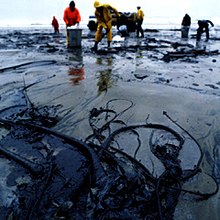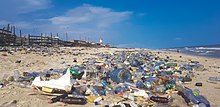


The environmental impact of the petroleum industry is extensive and expansive due to petroleum having many uses. Crude oil and natural gas are primary energy and raw material sources that enable numerous aspects of modern daily life and the world economy. Their supply has grown quickly over the last 150 years to meet the demands of the rapidly increasing human population, creativity, knowledge, and consumerism.[1]
Substantial quantities of toxic and non-toxic waste are generated during the extraction, refinement, and transportation stages of oil and gas. Some industry by-products, such as volatile organic compounds, nitrogen & sulfur compounds, and spilled oil can pollute the air, water and soil at levels that are harmful to life, when improperly managed.[2][3][4][5] Climate warming, ocean acidification, and sea level rise are global changes enhanced by the industry's emissions of greenhouse gases like carbon dioxide (CO2) and methane, and micro-particulate aerosols like black carbon.[6][7][8] Vehicle tailpipe emissions kill many people.[9]
Among all human activities, fossil fuel combustion is the largest contributor to the ongoing buildup of carbon in the Earth's biosphere.[10] The International Energy Agency and others report that oil & gas use comprises over 55% (18 billion tons) of the recorded 32.8 billion tons (BT) of CO2 released into the atmosphere from all energy sources in year 2017.[11][12] Coal use comprised most of the remaining 45%. Total emissions continue to rise nearly every year: from 1.7% to 33.1 BT in 2018.[13]
Through its operations, the petroleum industry directly contributed about 8% (2.7 BT) of the 32.8 BT in 2017.[11][14][15] Also, due to its intentional and other releases of natural gas, the industry directly contributed at least[16] 79 million tons of methane (2.4 BT CO2-equivalent) that same year; an amount equal to about 14% of all known anthropogenic and natural emissions of the potent warming gas.[15][17][18]
Along with fuels like gasoline and liquified natural gas, petroleum enables many consumer chemicals and products, such as fertilizers and plastics. Most alternative technologies for energy generation, transportation, and storage can only be realized at this time because of its diverse usefulness.[19] Conservation, efficiency, and minimizing waste impacts of petroleum products are effective industry and consumer actions toward achieving better environmental sustainability.[20][21][22]
- ^ The Library of Congress (2006). "History of the Oil and Gas Industry". Business and Economics Research Advisor (5/6).
- ^ "EPA enforcement targets flaring efficiency violations" (PDF). U.S. Environmental Protection Agency. 2012-08-01. Retrieved 2020-02-08.
- ^ "Frequent, routine flaring may cause excessive, uncontrolled sulfur dioxide releases" (PDF). U.S. Environmental Protection Agency. 2000-10-01. Retrieved 2020-02-08.
- ^ Bautista, H.; Rahman, K.M.M. (25 January 2016). "Review On the Sundarbans Delta Oil Spill: Effects On Wildlife and Habitats". International Research Journal. 1 (43): 93–96. doi:10.18454/IRJ.2016.43.143.
- ^ Bautista, H.; Rahman, K. M. M. (2016). "Effects of Crude Oil Pollution in the Tropical Rainforest Biodiversity of Ecuadorian Amazon Region". Journal of Biodiversity and Environmental Sciences. 8 (2): 249–254.
- ^ Eggleton, Tony (2013). A Short Introduction to Climate Change. Cambridge University Press. p. 52. ISBN 9781107618763.
- ^ Stohl, A.; Klimont, Z.; Eckhardt, S.; Kupiainen, K.; Chevchenko, V.P.; Kopeikin, V.M.; Novigatsky, A.N. (2013), "Black carbon in the Arctic: the underestimated role of gas flaring and residential combustion emissions", Atmos. Chem. Phys., 13 (17): 8833–8855, Bibcode:2013ACP....13.8833S, doi:10.5194/acp-13-8833-2013, hdl:11250/2383886
- ^ Michael Stanley (2018-12-10). "Gas flaring: An industry practice faces increasing global attention" (PDF). World Bank. Retrieved 2020-02-08.
- ^ "Air pollution from vehicle-tailpipe emissions and diagnostic approaches through cyber–physical platform - a review".
- ^ Heede, R. (2014). "Tracing anthropogenic carbon dioxide and methane emissions to fossil fuel and cement producers, 1854–2010". Climatic Change. 122 (1–2): 229–241. Bibcode:2014ClCh..122..229H. doi:10.1007/s10584-013-0986-y.
- ^ a b "Data and Statistics: CO₂ emissions by energy source, World 1990-2017". International Energy Agency (Paris). Retrieved 2020-02-09.
- ^ Hannah Ritchie; Max Roser (2020). "CO₂ and Greenhouse Gas Emissions: CO₂ Emissions by Fuel". Our World in Data. Published online at OurWorldInData.org. Retrieved 2020-02-09.
- ^ "Global Energy & CO2 Status Report 2019: The latest trends in energy and emissions in 2018". International Energy Agency (Paris). 2019-03-01. Retrieved 2020-02-09.
- ^ "Methane Tracker - Methane from oil and gas". International Energy Agency (Paris). 2020-01-01. Retrieved 2020-02-09.
- ^ a b "Tracking Fuel Supply - Methane emissions from oil and gas". International Energy Agency (Paris). 2019-11-01. Retrieved 2020-02-09.
- ^ Alvarez, R.A.; et al. (2018-07-13). "Assessment of methane emissions from the U.S. oil and gas supply chain". Science. 361 (6398): 186–188. Bibcode:2018Sci...361..186A. doi:10.1126/science.aar7204. PMC 6223263. PMID 29930092.
- ^ "Methane Tracker - Country and regional estimates". International Energy Agency (Paris). 2019-11-01. Retrieved 2020-02-09.
- ^ "Methane Tracker - Analysis". International Energy Agency (Paris). 2019-11-01. Retrieved 2020-02-09.
- ^ Vaclav Smil (2016-02-29). "To Get Wind Power You Need Oil". IEEE Spectrum. Retrieved 2020-02-09.
- ^ Amory Lovins (2018-09-18). "How big is the energy efficiency resource?". Environmental Research Letters. 13 (9). IOP Science: 090401. Bibcode:2018ERL....13i0401L. doi:10.1088/1748-9326/aad965.
- ^ Asim, Nilofar; Badiei, Marzieh; Torkashvand, Mohammad; Mohammad, Masita; Alghoul, Mohammad A.; Gasaymeh, Shawkat S.; Sopian, Kamaruzzaman (2021-02-15). "Wastes from the petroleum industries as sustainable resource materials in construction sectors: Opportunities, limitations, and directions". Journal of Cleaner Production. 284: 125459. doi:10.1016/j.jclepro.2020.125459. ISSN 0959-6526. S2CID 230552246.
- ^ twall (2022-12-08). "What oil and gas companies are doing to promote environmental sustainability". Plant Engineering. Retrieved 2023-06-13.